In celebration and support of International Women’s Day 2022, a number of colleagues and contacts crossed their arms to show solidarity in support of this year’s theme of #BreakTheBias.
Individuals and organisations are ever more committed to ‘Diversity, Equity, Inclusion and Belonging’ (DEIB). While positive change is taking place, there are still a lot of gaps as some women still experience gender bias, stereotypes, and discrimination in the workplace.
Recognising and breaking bias is high on many agendas. With this in mind, companies are having honest conversations about how they fully integrate DEIB into their company’s mission and purpose, while driving out implicit bias at a systemic level. As we enter a post-Covid era of work in which employees have more power, flexibility is the norm, and well-being is more important than ever, the opportunities to advance workplace gender equity are greater than ever.
The organisers of the 2022 International Women’s Day ask us to:
Imagine a gender equal world.
A world free of bias, stereotypes, and discrimination.
A world that is diverse, equitable, and inclusive.
A world where difference is valued and celebrated.
Together we can forge women’s equality.
Collectively we can all #BreakTheBias.
Every day this week, our contributors share their insights and observations into breaking the bias and what the theme means to them.
Lillian Forsyth – Lead with Equity
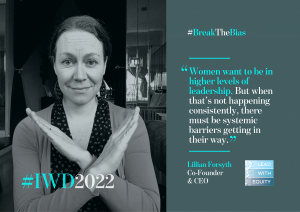
How can we move beyond unconscious bias training to eliminating the systemic biases and barriers for women in the workplace?
We’ve made some gains in representation in the past decade, but we’re still a long way from equity. The last two years have been a major equity setback for women in the workplace. A few stats to get you thinking:
According to a 2020 Women in Management global study done by Catalyst, the higher up you look in organisations, the fewer women you see.[1]
The 2021 Lean in Women in the Workplace study found that the places where women drop off the most in comparison to men are 1) in the initial transition to manager, 2) the transition from manager to senior manager.[2]
Yet, Gallup’s 2016 Women in America study showed that 45% of women aspire to CEO or other executive roles.[3]
So, what’s going on? If women want to be in higher levels of leadership, but that’s not happening consistently, there must be systemic barriers getting in their way.
What can employers do to start breaking down systemic biases?
Here are some ideas:
Provide leadership and executive development programs specifically targeted toward women transitioning to manager and senior manager levels. There is a different skill set that is required for anyone to thrive in a senior leadership role. This includes things like strategic relationship building, raising the visibility of your accomplishments, blocking out weekly time for strategic thinking, and exposure to different business units. Some of these skills are culturally discouraged for women, so we shy away from them. Employers can support women by providing opportunities to develop these skills.
Provide deliberate career pathing for women. A 2019 study of more than 3,000 professionals by Working Mother Research Institute and the National Association for Female Executives, suggests men and women receive very different career-building cues. In this study, men were three times as likely as women to have been encouraged to consider a P&L role. Employers can ensure that regular career conversations are happening equitably by providing managers with templates, resources and having a central location for career pathing data.
Provide flexible work options. Women are still more likely to be primary caregivers for children or others in their home. Providing options for less than 40 hours/week jobs, job sharing, or fully remote management and leadership roles will make it easier for women to prioritise family while still being able to contribute to your organisation at a high level.
[1] https://www.catalyst.org/research/women-in-management/ (Executives: 23%, Senior managers: 29%, Managers: 37%, Professionals: 42%, Support staff: 47%)
[2] https://www.mckinsey.com/featured-insights/diversity-and-inclusion/women-in-the-workplace
[3] https://www.gallup.com/workplace/238070/women-america-work-life-lived-insights-business-leaders.aspx
Tom Armstrong – HPC Executive Coach
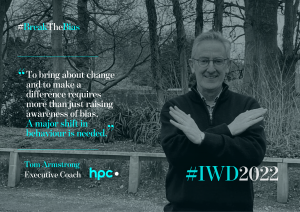
How can we move beyond unconscious bias training to eliminate the systemic biases and barriers for women in the workplace?
It’s a start to become aware that we have bias. But to bring about change and to make a difference requires more than just raising awareness.
Breaking through bias requires practicing an UNBIASED pathway:
Understand the experiences of others – get into the shoes of those who are at the wrong end of experiencing bias
Remember the Neuroscience – the brain is malleable and capable of positive change
Think about our own beliefs, conscious and unconscious, and our Behaviours – what are our behaviours saying?
Increase our interactions with those who we may demonstrate or practice bias against – Include them and get to know them better
Take positive Action to change to behaviours that are the opposite to our bias – act another way – against the bias
Show how to break the bias through action and speak out where we witness it
At moments that matter, ask yourself, is this Equitable and embracing Difference?
Awareness is a start – behaviour is a result. Be U N B I A S E D
Has working from home made it harder for women to progress?
Last year (2021), while working from home was at its peak, I carried out some collaborative research on the impact of remote working.
One significant finding was that men indicated they were having a more negative (or less positive) experience than women, across every heading of remote working that we examined.
The themes explored were wide ranging and covered sense of connection, work-life boundaries, productivity, motivation and more. Whatever the elements behind this finding, it suggests that (on average) women have managed and felt better about remote working than their male counterparts. This may predict that as hybrid working develops, women will spend less time at the office. An unfortunate and perhaps unintended consequence of this could be a concentration of power at the physical office, with those least in the office missing out on opportunities to progress and less participation in critical decision making. We don’t know the answer to the progress question yet, but we do know that it’s important to guard against the slow creep of exclusion.
Yvonne Farrell – HPC Senior Facilitator
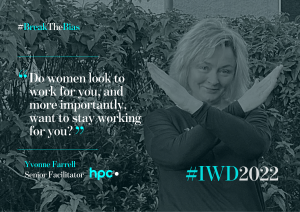
A diverse workforce brings varied perspectives that contribute to an organisation’s prosperity. We know that at a top level, only one in five C-suite leaders is a woman and fewer than one in 30 is a woman of colour, according to a study from LeanIn.org and McKinsey.
At all levels, organisations are trying to overcome this disparity. Many say that diversity is the number one priority on their company agenda, gender diversity being at the core of this. But it seems that there is a big disconnect between the good intentions of leaders and true progress on closing the gender gap.
So, what do organisations need to ask themselves as they try to cement an inclusive and diverse process of attracting, supporting and retaining women within their business?
Attracting female talent – What image does your organisation portray? What behaviours do you display? Does it attract or detract women? Examine your recruitment campaign ‘habits’ and ‘bias’. Challenge your traditional routes to candidate markets. Do you reach out to females early, in schools and colleges, to encourage them to consider a career with you? Revise the language in your job adverts and the images in your recruitment campaigns – are they gender balanced? Ask yourself, are women in non-traditional roles seen and celebrated? Are your interview panels gender balanced?
Support and Retention – Ask yourself what you are doing to nurture your pipeline of female talent. More importantly, understand their needs and desires by asking them. What does it mean for women to feel empowered, included, and acknowledged in this organisation? Are women encouraged and supported to go for promotion? Do you have flexible working policies that support women and their families?
Attracting and retaining female talent requires strategy and action. And the most important question to ask yourself is: Do women look to work for you, and more importantly, want to stay working for you?
Adam Burke – IDA Ireland
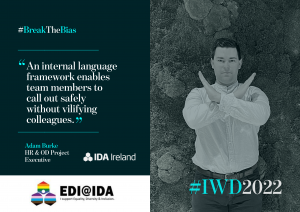
IDA’s most important asset is its people and, in a constantly evolving global economy, the organisation does its utmost to support career development, well-being, diversity, inclusion and belonging. Their company culture, leadership and people management are the bedrock on which they have built a fully integrated well-being and diversity approach.
Under its Diversity and Inclusion (D&I) Action Plan, IDA has taken a number of steps including membership of the 30% Club, the OUTstanding professional network, the IBEC Diversity Forum, and the Open Doors Initiative. IDA’s HR Team has included D&I in the induction programme for all new joiners, and there are D&I focused questions in the annual employee survey. New policies include those in the areas of home working, open location roles and increased levels of flexitime working – all designed to provide greater flexibility and a better work life balance for IDA team members.
We asked Adam:
How can we move beyond unconscious bias training to eliminate the systemic biases and barriers for women in the workplace?
“Mark Fenton of MASF Consulting coined the phrase “Catch it, Call it, Change it.” We are all navigating the evolution of language and we may not always get it right; an internal language framework enables Team Members to call out safely without vilifying colleagues. Empower everyone to speak up with ideas, questions, concerns or even mistakes. As Amy Edmondson says, “psychological safety is not at odds with having tough conversations – it is what allows us to have tough conversations”.”
Fiona Claridge – HPC Client Director
Why is recognising bias important?
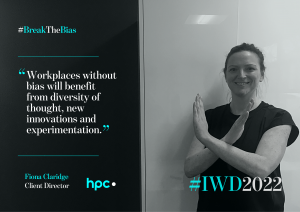
We can miss an opportunity to connect, share, learn, grow. Being aware of bias will help us to stop, lean in to a situation we might not otherwise have done and when that happens the outcome may surprise you, in all the right ways.
How have you witnessed companies breaking the bias?
It gives me such joy when I hear about companies who promote women, whilst out on maternity leave. I am hearing of this occurring more and more and commend any company who does so. They stick in my mind and I will make sure to make others aware of these great practices by promoting them to others.
Why is it particularly important to rebuild post-pandemic workplaces without bias?
Post-pandemic, there are huge opportunities to reinvent our work practices and processes – how we hire, assess for development and evaluate success. So much has changed and we are unconsciously re-evaluating the “why’s” across our business. Workplaces without bias will benefit from diversity of thought, new innovations and experimentation – the key to future business success.
How has remote work & the COVID19 pandemic changed your approach to advancing women in your workplace?
I now look at it in a much more holistic way. Before I was solely focused on what happens during “working hours”. I have had the absolute realisation that this is only a fraction of the time that needs to be focused on in terms of supporting women in their careers. So much of our success in work is dependent on what is happening outside of work.
About our Contributors
About Lillian
Lillian is an experienced coach and workshop facilitator in the areas of communications, leadership, and diversity, equity and inclusion. She has held communications, operations and human resources leadership roles with both for-profit and non-profit organisations.
Through her work she continually noticed a common theme: individual leaders and entire organisations struggling to engage, retain, and promote people from historically underrepresented backgrounds. This was the impetus for starting Lead with Equity, where her role is to help leaders to lead more effectively, inclusively, and equitably and to help organisations embed these skills into their leadership systems.
Connect with Lillian on LinkedIn >>>
About Tom
Tom is a member of HPC’s Executive Coaching Panel. In addition to his coaching qualifications, he has over 25 years’ experience working as a senior executive within various sectors.
Tom’s executive coaching experience has enabled him to coach in a wide variety of environments including executives in small, medium and large private sector companies, as well as private individuals and leaders in public organisations. He offers his clients a safe space to explore options and ideas, and to raise awareness, thereby facilitating personal and professional growth and development.
About Yvonne
Yvonne is a highly proficient HR Professional with a wealth of practical experience in all areas of people development. Her expertise in business and career coaching adds strength to her HPC facilitation work across all organisational levels.
Yvonne has over 25 years’ industry experience in the management and development of people and has held a variety of senior roles, including Head of People and Organisational Capability at Vodafone Ireland. Her extensive business experience enables Yvonne to excel in the design and delivery of effective programmes across HPC’s client base, with a particular interest in behaviour change and competency development in management and personal development.
About Adam
Adam is an HR & OD Project Executive at IDA Ireland. Through his experience of Learning & Development, he is passionate about supporting the growth of others – helping them improve their physical, mental and emotional wellbeing at home and in the workplace.
He has dedicated time to a Masters in Work & Organisational Psychology due to a huge interest in HR practices and also the degree in which companies can impact employees’ wellbeing.
Throughout this career, he has trained and developed thousands of learners; supported businesses in improving their customer’s experience by delivering live workshops and seminars; and delivered talks at industry conferences, webinars, and created bespoke content.
Connect with Adam on LinkedIn >>>
About Fiona
Fiona’s role as Client Director within HPC is to partner with organisations to shape bespoke people development solutions that achieve impactful results. She works in partnership with clients across a diverse range of industry sectors and offers a deep understanding of how ever-changing business needs impact how HPC’s work adds value at a strategic level.
HPC has been designing and delivering people development solutions for 40 years, partnering with clients to create a high-performance culture that has a positive impact on business growth and personal development.